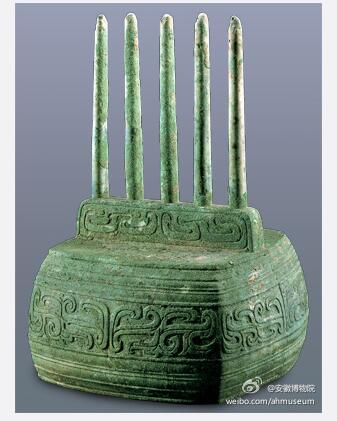


An article about a router-like artifact in ancient China recently went viral online, Chinanews.com reported on Wednesday.
This unique bronze ware features five round columns standing on a square base at an equal distance between each other, strongly resembling a Wi-Fi router with five tentacles in the eyes of modern people. Some net users even nicknamed it the “West Zhou Dynasty router.”
This 31-centimeter-high piece unearthed in 1959 can be dated back to the West Zhou Dynasty, over 3,000 years ago. The national-level cultural relic and national treasure is housed in central China’s Anhui Museum.
According to the museum’s website, no clues of its functions were found among scholars’ records and literature about the “router-shaped ware.”
No inscriptions, no literary records, or other similarly shaped pieces. It’s even not officially named owing to these reasons.
Early in 1959, the anonymous relic was excavated at a village in southern Anhui province near the Yangtze River, in what is now the Huangshan Airport. Earlier reports speculated that it might be a piece of instrument as five sticks stand for five notes. And some archeologists argued that it’s a pipe holder. But these assumptions were later refuted as no instruments were unearthed in the tomb.
Some academic speculations still need evidence, said Li Yizhi, deputy director of Anhui Museum. And it’s fine that some net users jokingly call it the “West Zhou Dynasty router” for entertainment, Li responded.
 Fire brigade in Shanghai holds group wedding
Fire brigade in Shanghai holds group wedding Tourists enjoy ice sculptures in Datan Town, north China
Tourists enjoy ice sculptures in Datan Town, north China Sunset scenery of Dayan Pagoda in Xi'an
Sunset scenery of Dayan Pagoda in Xi'an Tourists have fun at scenic spot in Nanlong Town, NW China
Tourists have fun at scenic spot in Nanlong Town, NW China Harbin attracts tourists by making best use of ice in winter
Harbin attracts tourists by making best use of ice in winter In pics: FIS Alpine Ski Women's World Cup Slalom
In pics: FIS Alpine Ski Women's World Cup Slalom Black-necked cranes rest at reservoir in Lhunzhub County, Lhasa
Black-necked cranes rest at reservoir in Lhunzhub County, Lhasa China's FAST telescope will be available to foreign scientists in April
China's FAST telescope will be available to foreign scientists in April "She power" plays indispensable role in poverty alleviation
"She power" plays indispensable role in poverty alleviation Top 10 world news events of People's Daily in 2020
Top 10 world news events of People's Daily in 2020 Top 10 China news events of People's Daily in 2020
Top 10 China news events of People's Daily in 2020 Top 10 media buzzwords of 2020
Top 10 media buzzwords of 2020 Year-ender:10 major tourism stories of 2020
Year-ender:10 major tourism stories of 2020 No interference in Venezuelan issues
No interference in Venezuelan issues
 Biz prepares for trade spat
Biz prepares for trade spat
 Broadcasting Continent
Broadcasting Continent Australia wins Chinese CEOs as US loses
Australia wins Chinese CEOs as US loses